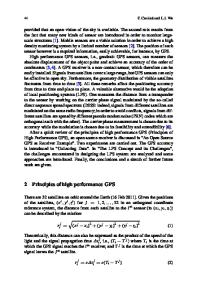Global Positioning System and Sport-Specific Testing
- PDF / 266,913 Bytes
- 9 Pages / 504 x 720 pts Page_size
- 41 Downloads / 533 Views
LEADING ARTICLE
© Adis Data Information BV 2003. All rights reserved.
Global Positioning System and Sport-Specific Testing Peter Larsson Department of Surgical and Perioperative Sciences, Sports Medicine Unit, Ume˚a, Sweden
Abstract
Most physiological testing of athletes is performed in well-controlled situations in the laboratory. Multiple factors that are hard to control for have limited the use of sport-specific field testing. Recently, the technique of the differential global positioning system (dGPS) has been put forward as a way to monitor the position and speed of an athlete during outdoor activities with acceptable precision, thus controlling the two most important factors of performance in endurance athletics, i.e. inclination and speed. A detailed analysis of performance has been shown to be possible in combination with metabolic gas measurements. The combination of accelerometry and dGPS has also been shown to improve physiological field testing. The technique of dGPS could probably also be combined with other bio-measurements (e.g. electromyography and cycling cadence and power) and may enable other studies of exercise physiology in the field, otherwise restricted to the laboratory environment. This technique may also be of use in general exercise physiology where monitoring of patients with, for example, cardiovascular and pulmonary diseases, could be of interest for the future.
Most physiological testing of athletes is performed in well-controlled situations in the laboratory. The laboratory-derived physiological variables are often used to measure performance or evaluate training effects. However, the drawback of the well-controlled situations is that no laboratory test measures sport-specific performance. Sport-specific physiological testing has been made easier to perform during the last decades, especially with the development of heart-rate monitors and lightweight metabolic gas measurement systems. However, problems are still experienced with factors that are hard to control for[1] such as difficulties achieving standardised conditions in the field-test situation (e.g. air-resistance, outdoor temperature, ski glide). The two factors probably having the most influence on the physiological response in endurance athletics are inclination and speed. An increase or decrease in
these two parameters will clearly influence most of the measurable physiological variables.[2] In most previous field tests, only the trends of physiological data have been studied without taking into consideration the position and speed of the study participants,[3-5] or the field tests were designed to achieve maximal values only.[6,7] Other field tests have been simplified in order to get a more controlled test situation. For example, the physiological demands of cross-country skiing have been studied during skiing on flat ground,[8-10] and during orienteering on a predetermined course through the terrain.[11-14] To control for speed, previous field tests have measured time on a known distance,[7,12,15-19] or have let s
Data Loading...











